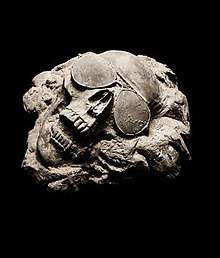The Uninhabitable Earth

The Uninhabitable Earth is a New York magazine article by American journalist David Wallace-Wells published on July 9, 2017. The long-form article depicts a worst-case scenario of what might happen in the near-future due to global warming. The article starts with the statement "[i]f your anxiety about global warming is dominated by fears of sea-level rise, you are barely scratching the surface of what terrors are possible." According to David Wallace-Wells, the story was the most read article in the history of the New York Magazine.[1]
General
On November 20, 2017, NYUs Arthur L. Carter Journalism Institute hosted a 2 hour long conversation between Wallace-Wells and Michael E. Mann to discuss the controversy around the article.[1]
Accompanying the article are a series of extended interviews with scientists. These include paleontologist Peter Ward,[2] climatologist Michael E. Mann[3] oceanographer Wallace Smith Broecker,[4] climatologist James Hansen[5] and scientist Michael Oppenheimer.[6] In addition an annotated edition of the article was published online that includes inline footnotes.
Reception
The story received immediate criticism from the climate change community along two fronts: the piece is too pessimistic; or it contains some factual errors.[7]
Robinson Meyer of The Atlantic said it is an "unusually specific and severe depiction of what global warming will do to the planet." [8] Susan Matthews writing in Slate said "The instantly viral piece might be the Silent Spring of our time".[9]
The NGO Climate Feedback summarized reviews by dozens of professional scientists and concluded the majority of the reviewers tagged the article as: Alarmist, Imprecise/Unclear, Misleading.[10]
Some journalists defended the science saying it is mostly correct, "I haven’t seen any good evidence for serious factual errors," said Kevin Drum.[7] Emily Atkin said "The complaints about the science in Wallace-Wells’s article are mostly quibbles".[11]
The major criticism is that David Wallace-Wells was trying to scare people.[7] This theme was then explored by journalists and commentators with some saying they thought fear was necessary given the reality of the problem, while others thought scaring people was counter-productive.[8][9][7][11][12] For example, Eric Holthaus said that "scaring the shit out of [people] is a really bad strategy" for getting them to want to address climate change.[13]
In a later interview, David Wallace-Wells said "it didn’t seem plausible to me that there was more risk at scaring people too much than there was at not scaring them enough ... my feeling was, and is, if there's a one percent chance that we’ve set off a chain reaction that could end the human race, then that should be something that the public knows and thinks about." [14]
References
- 1 2 Robert Lee Hotz (November 20, 2017). "The 'Doomed Earth' Controversy". Arthur L. Carter Journalism Institute. Retrieved March 31, 2018.
- ↑ David Wallace-Wells (July 10, 2017). "'The Models Are Too Conservative': Paleontologist Peter Ward on What Past Mass Extinctions Can Teach Us About Climate Change Today". New York. Retrieved July 11, 2017.
- ↑ David Wallace-Wells (July 11, 2017). "Scientist Michael Mann on 'Low-Probability But Catastrophic' Climate Scenarios". New York. Retrieved July 11, 2017.
- ↑ David Wallace-Wells (July 10, 2017). "The Man Who Coined the Term 'Global Warming' on the Worst-Case Scenario for Planet Earth". New York. Retrieved July 13, 2017.
- ↑ David Wallace-Wells (July 12, 2017). "'The Planet Could Become Ungovernable': Climate Scientist James Hansen on Obama's Environmental Record, Scientific Reticence, and His Climate Lawsuit Against the Federal Government". New York. Retrieved July 14, 2017.
- ↑ David Wallace-Wells (July 13, 2017). "'Personally, I Would Rate the Likelihood of Staying Under Two Degrees of Warming As Under 10 Percent': Michael Oppenheimer on the 'Unknown Unknowns' of Climate Change". New York. Retrieved July 14, 2017.
- 1 2 3 4 Kevin Drum (July 10, 2017). "Our Approach to Climate Change Isn't Working. Let's Try Something Else". Mother Jones. Retrieved July 11, 2017.
- 1 2 Robinson Meyer (July 10, 2017). "Are We as Doomed as That New York Magazine Article Says?". The Atlantic. Retrieved July 11, 2017.
- 1 2 Susan Matthews (July 10, 2017). "Alarmism Is the Argument We Need to Fight Climate Change". Slate. Retrieved July 11, 2017.
- ↑ "Scientists explain what New York Magazine article on "The Uninhabitable Earth" gets wrong". Climate Feedback. July 12, 2017. Retrieved July 13, 2017.
- 1 2 Emily Atkin (July 10, 2017). "The Power and Peril of "Climate Disaster Porn"". New Republic. Retrieved July 11, 2017.
- ↑ Dino Grandoni (July 11, 2017). "The Energy 202: Trump could start his infrastructure push at Energy Department". Washington Post. Retrieved July 11, 2017.
- ↑ Eric Holthaus (July 10, 2017). "Stop scaring people about climate change. It doesn't work". Grist. Retrieved July 11, 2017.
- ↑ Rebecca Fishbein (July 10, 2017). "Are Humans Doomed? A Q&A With The Author Of NY Mag's Terrifying Climate Change Story". Gothamist. Archived from the original on July 10, 2017. Retrieved July 11, 2017.
External links
- David Wallace-Wells (July 9, 2017). "The Uninhabitable Earth". New York. Retrieved July 11, 2017.
- David Wallace-Wells (July 14, 2017). "The Uninhabitable Earth, Annotated Edition". New York. Retrieved July 14, 2017.